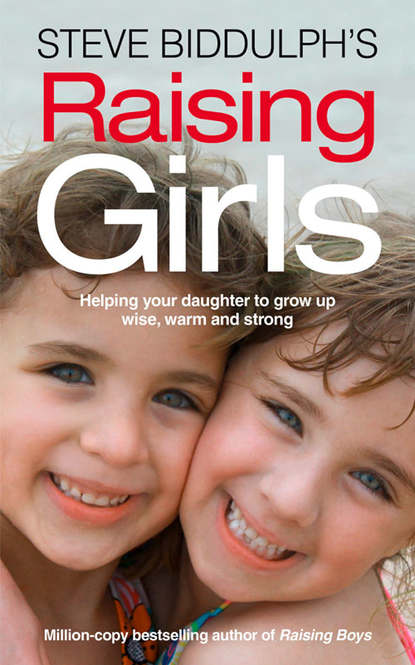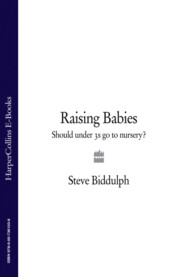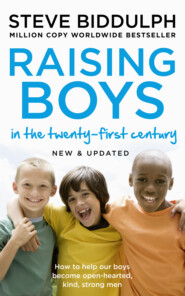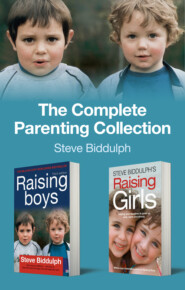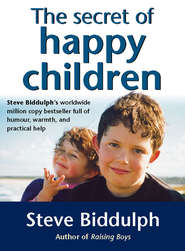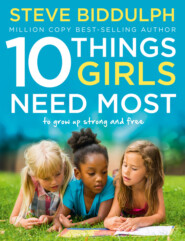По всем вопросам обращайтесь на: info@litportal.ru
(©) 2003-2024.
✖
Steve Biddulph’s Raising Girls
Автор
Год написания книги
2018
Настройки чтения
Размер шрифта
Высота строк
Поля
Parents who know the map of girlhood can organise their lives to provide what is needed.
It’s your daughter who makes the journey, but you are her coaches, caregivers and allies along the way. Taking on these roles is probably the best thing you will ever do.
Chapter 2
Right from the Start (#u1f73528b-8ea2-5b84-8f16-1a377b1f62cf)
(Birth–2 years) (#u1f73528b-8ea2-5b84-8f16-1a377b1f62cf)
It’s early morning and little Lucy, just five weeks old, is lying wide awake in her cot beside her parents’ bed. Her mum and dad are both asleep, in fact her dad is lightly snoring. Lucy watches the dancing shadows made by the sunlight on the wall. From time to time, she waves her arms in sheer delight. She makes happy noises, and her head turns from side to side as she takes in the wonder of the world.
After a while, Lucy starts to feel hungry. She whimpers, and her mother, ears attuned for her baby’s sounds by a million years of mammalian history, wakes up, even though her husband’s snoring has not disturbed her all night. She reaches over and sleepily brings Lucy into the bed, then unbuttons a milk-swollen breast for her to suckle on. Lucy hasn’t needed to get upset, so she settles happily to feed, fully alert, looking into her mum’s eyes as she does so. At this age the focal length of her eyes is fixed at just the right distance to her mother’s face when feeding, about 30 centimetres, anything further away is still blurred. All she needs to see clearly is that her mum is happy and content. Then she can relax too.
Soon the day will begin. Lucy and her mum or dad will move through different activities, going down the street to the shops, perhaps meeting or dropping in on friends. There will be many changes of nappies, many feeds. But most of this time Lucy will be just lying about, or sleeping. Breastfeeding and sleeping, without any special effort, are the main events of early babyhood. And through all of this, Lucy’s brain will be growing; in just this first year of life, it will double or even treble in size. It will never grow so fast or so well as in these early months, though. It is the love, smiles, songs and playful interactions and all the other myriad natural things that parents do with babies, that help it to grow.
Learning to Connect
As her mum goes about her activities around the house, or at her computer, if Lucy gets lonely she will make sounds to attract her mum’s attention. And her mum will answer her. While Lucy will not have words for a year or so, she and her mother know exactly what the other is communicating. Roughly translated, the conversation goes like this …
Baby: ‘Are you there, beloved one?’
Mum: ‘Yes, I am!’
Baby: ‘Am I still the most important thing in your life?’
Mum: ‘Yes, you are.’
Baby: ‘Just checking!’
Mum: ‘That’s fine.’
Researchers have filmed these mother-baby exchanges using special high-speed cameras, and have given them a scientific name3 (#litres_trial_promo): ‘Joint attention sequences’ are the little rituals when mother and baby check in with each other, and they happen dozens of times a day. These mini ‘conversations’ help make this child not just secure in her mother’s love but, as she gets older, better able to relate empathically and sensitively to other people. The timing is incredibly sensitive, they seem to sway and move in total harmony. Researchers found that if the mum is on a video screen, it still works, but if they introduce a mere one-second delay, the baby completely panics. The rhythm of this baby and this mother are totally attuned. The delicate dance of interaction, with sounds and nods, smiles and bits of sing-song, shape this little girl’s abilities to relate well for life.
Often Lucy’s cries will be more intense, if something has scared her or she has a moment of painful hunger, or because something is not to her liking. Her mother will match this startle response with, ‘Oooh, what’s wrong?’ or, ‘Oh dear, what’s the matter?’ using the higher-pitched voice that adults tend to adopt around babies. This voice is more audible to a baby’s ears. (Though nobody knew that until recently audiologists learned how to measure it.) The mother will then shift her pitch and tone to a more soothing level. She will probably pick Lucy up and rock her gently to restore some rhythmic peace. From thousands of such soothings Lucy’s brain will learn the pathway from stress to relaxation, a pathway she can use for all her life to come.
Lucy and her parents’ time together will have a quality that is called ‘responsiveness’. Put simply, they will be tuned in to her and will get to know her ways. They will read her signals and respond, not in a panicky way, but smoothly and contentedly. Partly this is simply how love (and the hormone of love, known as oxytocin) works, but partly it’s because they have made it a priority to be not too busy or rushed in these early months. (They didn’t decide to renovate the bathroom or take a big promotion right now, knowing that babyhood was a pretty demanding event on its own.) Unless Lucy’s mum is numbed out by drug addiction, or is suffering from depression, she will most likely find Lucy delightful to be around, though certainly demanding. Parenthood may not come naturally, but it will grow and settle into a new and satisfying rhythm, if she gives it time and if she has support from those around her.
Support from grandmas, friends, aunties is very important. New mums or dads can’t easily do this stage on their own, they need a bit of mothering too. Love is like a river and it has to flow in and out of us. Being close to family and friends really helps when you have a little baby.
People Skills Start Very Young
As adults we know that people skills make a huge difference in life. We notice it most when they are not there – a hugely insensitive boss or colleague, a person in the street or a shop who is clueless and uncaring. Awareness of other people’s feelings, the timing of conversation, knowing when to listen and when to speak, are complex and advanced skills. Most of us have had moments with another person where we are awkward, where perhaps the timing gets jumbled up. Hopefully this is just momentary; often it’s when we are trying too hard, or wanting to impress. We lost our own ‘realness’. Some people we meet are extraordinarily engaged and sensitive and we feel great to be with them, noticed and valued. For a social animal like us, harmonious interaction is central to our happiness.
That’s why we start learning long before we can even speak. Interestingly, it’s the second six months of human life that seem to matter the most. This is the time when a baby gets much more fussy about who is around them. Mothers have known for thousands of years that a newborn can be shared around, but a six-month-old baby knows exactly who its mum and dad are, and often won’t trust anyone else.
Neuroscience bears this out. It’s in the second six months of life that the baby grows those areas of the brain that are specifically for people skills. Girl babies have more aptitude and awareness of social connection, which is a natural strength of girls, but this still must be nurtured and strengthened. It’s not a matter of being self-conscious or deliberate – that would actually get in the way – you just go with the flow. Your baby calls you, you respond. It’s casual, natural, and soothing for you both.
Growing the PFC
The first six months of little Lucy’s life are rather sleepy, as she just gets used to being out in the world. In the second six months things speed up. Just inside her little forehead is an area of the brain that, if you could see it, looks like a cauliflower, wrinkled and furrowed. This area, known as the prefrontal cortex, is now starting to grow. The PFC is the most complex part of the brain, and it governs some things that are very important for life. The prefrontal cortex is the seat of empathy, sociability and human contact. It’s what makes us human.
The prefrontal cortex couldn’t grow earlier, because it would have made Lucy’s head too big to be safely born. And what’s in there, the software, also needs to be programmed by Lucy’s parents or carers, because they are unique to her family and culture and will help her live with them for the many years it will take to raise her.
Along with its social functions, the prefrontal cortex also controls two important abilities:
1 The ability to focus, to pay attention.
2 The ability to calm yourself down.
Babies can’t calm themselves for one important reason: they are wired up for panic. In the wild (the way we used to live for a quarter of a million years) babies were carried about for most of the day, because that was the best way to keep them safe and give them good care. And often the adults were walking for much of the time, so it was just a practical necessity. (Even today, in the so-called undeveloped world, babies are rarely put down. They also rarely cry.) In our long pre-history there were plenty of predators about that would love to snatch a human baby for their dinner. So if a baby found herself alone or, worse still, a big hairy muzzle suddenly appeared in her face, dripping saliva – and it wasn’t dad – she was probably in trouble. Babies who cried loudly were more likely to be rescued fast. So fearfulness and noisy panic had a survival value that became part of our design.
This alarm system in babies left alone has a very important message for us as parents. For just as we are told right from birth to keep babies warm – since they can’t regulate their own temperature – we have to keep them calm because they can’t regulate their emotions. So dozens of times a day, a baby gets upset, whimpers or cries, and her mum, dad, grandparent or sibling picks her up, soothes her, and helps her relax. ‘It’s okay, everything’s fine, there, there.’ Gradually this soothing becomes part of her, she learns how to do it herself, but this takes several years of receiving the gift of calmness from others. It’s all gradually building into strong mental health for a lifetime.
The Gift of Calm
Your little girl learns calmness for life from the ease and comfort you bring to her early months and years. (Even in the womb, your adrenaline crosses over into her body, so a calm pregnancy can pay off in terms of giving you a more restful and happy baby.) This means planning as much as you possibly can to spend the time before and after your birth and right into the first year or two, with reduced pressure and the luxury of time with your little one.
This is so different to our idea of how to live: rush, hurry and busy-ness are the keystones of modern life. But our babies are Stone-Age babies, and modern madness does not serve them well. If you possibly can, make this time a break from the rush-about world you may have lived in all your life.
WHAT IS CALMNESS?
Calmness is not a character trait, it’s simply a skill. You have to decide that it matters, that the quality of your presence would be better if you slowed yourself down and were really connected to people and the moment you are living in. Then you practise until gradually it becomes part of you. It benefits everyone around you – they feel peaceful and happy in your presence. It’s exactly what children need in a parent. And it benefits you – with less stress hormones, you live longer and feel better. Calmness is well worth cultivating.
Calmness is made up of certain actions; breathing deeper, dropping your shoulders, settling your muscles, feeling your feet strongly planted on the ground, focusing your thoughts on the job in hand in a steady easy way, and not going off into panicked thoughts. Even just counting three or four breaths, in and out, will slow your heartbeat and calm your mind down. Calm people are actually doing these things automatically; when an emergency strikes they intentionally calm themselves more in order to counter the tendency to panic and do the wrong thing.
Self-regulating your level of emotional arousal is an incredibly valuable skill for life. All you have to do is notice, am I calm? If not, breathe a couple of times consciously, feel your feet on the ground, and notice how, as the last burst of adrenaline clears away, the calmness response starts to kick in. Practise this for a few days, and soon the natural appeal of calmness will pull you more and more to that peaceful and steady place. Everything is better – the taste of food, the scent of flowers, the feel of the water in your shower, warm on your skin. You will find that time slows down, and you can think more in the pause before you open your mouth. And that has real benefits!
Crying and Sleep
Feeling okay in the world is the first lesson you teach your baby girl. ‘You are loved and precious, I am here for you, and everything is okay’. A frightened or lonely baby won’t learn to calm herself if she is just left to cry – this is a common misunderstanding. She will go quiet eventually, but this is because of another survival pattern. ‘Nobody is going to come!’ A baby’s prolonged cries ‘in the wild’ might attract danger, so if her cries are not successful after a few minutes, the baby shuts down and becomes physiologically ‘depressed’. If parents are unresponsive – through suffering untreated postnatal depression, or being drunk or stoned, or just not caring – and if this happens often enough, the baby decides that ‘my efforts don’t have any effect on others’. This pattern will become part of how she responds to difficulty in life. It is called ‘learned helplessness’.4 (#litres_trial_promo)
It’s not a pattern you want your child to have, because she will lack a sense of mastery or hope in difficult situations. ‘Depression’ is often misunderstood – it is simply an ability of the human body to shut down, from ancient times when we had to sit out bad weather or endure long winters of cold and dark. At such times, with little food about and no energy to catch it, moving little, eating little and doing little was the best way to survive. But the depression response can easily become overdeveloped. Teaching depression to a child by ignoring her is not going to help her. She may lie still, but she is actually very unhappy.
There is a middle road here; especially when getting babies to sleep, which can be an important part of parents’ survival. Sometimes a baby in her cot will make sounds, trying to bring the adults to play with her after she’s been put to bed. It’s fine to let her whinge and whine a little as part of her giving up on ‘game time’ and letting sleep take over (especially when mum or dad is totally knackered and just needs a rest), but if the whingeing turns into full-voiced distress, that’s not good. She needs calming and settling. The caring bond between you is endangered, and she needs to know you are there. (In the notes you will find some good reading suggestions on how to get more sleep for your baby, and for you, without using harsh methods to do so.)
You Also Have to Excite Your Baby!
After all this talk about calmness, it’s important to remember the opposite message too: we don’t always want our babies calm. Babies and toddlers also need to learn to go into higher states of excitement, to increase their emotional range and enjoyment. From time immemorial, parents and siblings will just naturally tickle, tease, excite and stimulate babies. Your little girl will giggle and ‘come alive’ when you energise her in whatever way works for you – singing to her, playing peek-a-boo by hiding your face behind your hand or a magazine and popping out again. Tickles, cuddles and dancing about with her in your arms will help her coordination and body sense, but don’t do it for that reason, do it for the fun of it. Put some music on, and let yourself go!
Even the rough and tumble play that dads do with small children helps this along. Dads are notoriously prone to exciting kids by tossing them about, chasing and wrestling and swinging them around. Your daughter may get a little stressed by this, but if it is done in the right way (which you can tell by watching her face for signs of real distress, and backing off a little) she will get over it and start to giggle. Research has found that little girls who play with their dads when they are toddlers are much more stress-proof than those who had it all too safe and gentle!5 (#litres_trial_promo)
(A cautionary note, especially for dads, when a baby is little, be careful with their necks – and their body generally. A baby cannot support the weight of their head with their little neck for many months and it may flex to the point of injury or sprain. Always support their head and neck firmly as you move them about.)
There is something else even more important: setting an example of fun. Your daughter learns most by watching you. If you are happy, exuberant, silly and fun with her at those times that it is appropriate (i.e. not when driving the car), then her capacity for being happy will grow. If you are friendly to people you meet, enjoy getting your clothes on, sing while you shower, are kind to people in shops or in the street, speak well of people, get cross when you see something unjust or wrong, then your daughter will be taking in and making these attitudes her own, from a surprisingly young age.
It’s worth checking up on this – especially for mums, who are the number one role model for their daughter’s whole approach to life. Spend a day having a close look at yourself; do you frown, stress, grump and hurry your way through life? If that is so, being the mother of a newborn little girl might make you want to change that.
THE HORMONES OF LOVE





